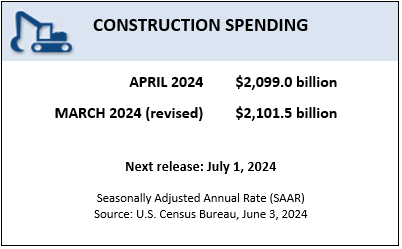According to the U.S. Census Bureau, construction spending during April 2024 was estimated at a seasonally adjusted annual rate of $2,099.0 billion, 0.1% (±1.0%) below the revised March estimate of $2,101.5 billion.
The April figure is 10.0% (±1.5%) above the April 2023 estimate of $1,907.8 billion. During the first four months of this year, construction spending amounted to $635.5 billion, 10.9% (±1.2%) above the $573.0 billion for the same period in 2023.
In April, the estimated seasonally adjusted annual rate of public construction spending was $487.1 billion, 0.2% (±2.1%) below the revised March estimate of $488.2 billion.
- Highway construction was at a seasonally adjusted annual rate of $149.6 billion, 0.5% (±6.7%) below the revised March estimate of $150.4 billion.
- Educational construction was at a seasonally adjusted annual rate of $103.5 billion, 0.2% (±2.1%) below the revised March estimate of $103.6 billion.
Spending on private construction was at a seasonally adjusted annual rate of $1,611.9 billion, 0.1% (±0.7%) below the revised March estimate of $1,613.3 billion.
- Residential construction was at a seasonally adjusted annual rate of $890.4 billion in April, 0.1% (±1.3%) above the revised March estimate of $889.5 billion.
- Nonresidential construction was at a seasonally adjusted annual rate of $721.5 billion in April, 0.3% (±0.7%) below the revised March estimate of $723.8 billion.
“Overall spending slipped despite upturns in manufacturing and power construction and a slight pickup in single-family homebuilding,” said Associated General Contractors of America Chief Economist Ken Simonson, the association’s chief economist. “Most public segments continued a seesaw pattern, with decreases in April following gains in other recent months.”
Association officials said they will be releasing a new report, co-authored by the Progressive Policy Institute, next week detailing the massive federal funding gap between support for collegiate education and investments in career and technical education for fields like construction. They are continuing to urge policy makers to boost funding for construction education and training programs and find new ways to allow more people to enter the country lawfully to work in construction.

“Nonresidential construction spending fell for the second consecutive month in April but remains just 0.3% below the all-time high established in February,” said Associated Builders and Contractors (ABC) Chief Economist Anirban Basu. “An unprecedented increase in manufacturing construction spending has pushed overall nonresidential activity 31.9% higher over the past two years. Ongoing investment in industrial facilities as well as significant infrastructure-related outlays will keep nonresidential spending elevated despite the current expectation that interest rates will stay higher for longer. This outlook is reflected in ABC’s Construction Confidence Index, which shows that a majority of contractors expect their sales to increase over the next two quarters.”
